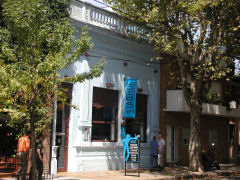 Buenos Aires – It may have just been coincidence, or it may have been because he knew I’m heading to Uruguay next week, but my new friend, whom I shall call “Pierre” to protect his identity, chose an Uruguayan parrilla for our lunch yesterday. He’s a local food and wine writer and restaurant reviewer, and it was on his list of places to check out, so off I went to meet up with him in Palermo Viejo at La Celeste,
Buenos Aires – It may have just been coincidence, or it may have been because he knew I’m heading to Uruguay next week, but my new friend, whom I shall call “Pierre” to protect his identity, chose an Uruguayan parrilla for our lunch yesterday. He’s a local food and wine writer and restaurant reviewer, and it was on his list of places to check out, so off I went to meet up with him in Palermo Viejo at La Celeste, Medrano 1475 Bonpland 1944. “Celeste” means both heavenly and sky-blue, and the owners are clearly going for a bit of each, from the exterior color to the Uruguayan flags draped throughout the interior, to a clear passion for what they’re doing that says “we do it better.” [Closed]
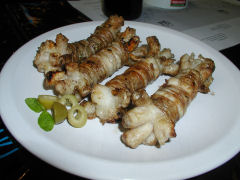 A conversation with our young waiter revealed that other than a few items which we’d noted as unfamiliar, most of the menu, which looked pretty standard parrilla-esque, was indeed more or less what one could expect at any local parrilla, just better. We decided to delve into the specialties of the house, beginning with a bottle of one of the two available Uruguayan wines, the Don Pascual Tannat 2004, a full-bodied red, ripe and ready for drinking with grilled meats. That meant shortly thereafter being confronted by a plate of chotos. I’ve had, and liked, many a time, chinchulines, the grilled small intestine of a calf or cow. The young man said we could expect the same, only from a chivito, or young goat. Well, I’m not so sure – unless the intestine of a goat has multiple branches, there’s something not quite correct here. I’m not – and I did a lot of fruitless online looking and I’ll ask next week when I’m in Uruguay – exactly clear what they are. Honestly, anatomically they look more like a trachea to me, but that would have all sorts of rigid rings on it, which these didn’t. I found one reference to them as “rolled and grilled braids of small intestine” without reference to goats – it certainly fits the picture better – otherwise goats clearly have a strange digestive system.
A conversation with our young waiter revealed that other than a few items which we’d noted as unfamiliar, most of the menu, which looked pretty standard parrilla-esque, was indeed more or less what one could expect at any local parrilla, just better. We decided to delve into the specialties of the house, beginning with a bottle of one of the two available Uruguayan wines, the Don Pascual Tannat 2004, a full-bodied red, ripe and ready for drinking with grilled meats. That meant shortly thereafter being confronted by a plate of chotos. I’ve had, and liked, many a time, chinchulines, the grilled small intestine of a calf or cow. The young man said we could expect the same, only from a chivito, or young goat. Well, I’m not so sure – unless the intestine of a goat has multiple branches, there’s something not quite correct here. I’m not – and I did a lot of fruitless online looking and I’ll ask next week when I’m in Uruguay – exactly clear what they are. Honestly, anatomically they look more like a trachea to me, but that would have all sorts of rigid rings on it, which these didn’t. I found one reference to them as “rolled and grilled braids of small intestine” without reference to goats – it certainly fits the picture better – otherwise goats clearly have a strange digestive system.
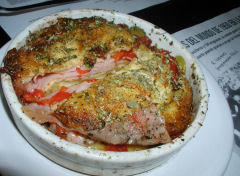 This was followed up shortly by one of the more interesting provoletas that I’ve had. There’s little better in this world than a nice slab of grilled or fried cheese. This particular dish, a provoleta rellena takes the usual thick slice of provolone and splits it, filling the inside with sliced prosciutto, green olives, roasted red peppers, and a sprinkling of herbs and red pepper flakes, and then cooking the whole thing on the parrilla and under a broiler. It’s a particularly delightful version of provoleta that I’d be happy to have again and again!
This was followed up shortly by one of the more interesting provoletas that I’ve had. There’s little better in this world than a nice slab of grilled or fried cheese. This particular dish, a provoleta rellena takes the usual thick slice of provolone and splits it, filling the inside with sliced prosciutto, green olives, roasted red peppers, and a sprinkling of herbs and red pepper flakes, and then cooking the whole thing on the parrilla and under a broiler. It’s a particularly delightful version of provoleta that I’d be happy to have again and again!
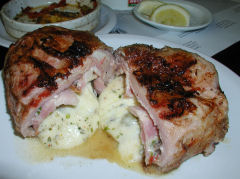 The classic Uruguayan dish off the parrilla is the pamplona. In some ways it is unfortunate that this followed directly after the provoleta rellena – as it’s somewhat of a repeat. It was still excellent – available in pork, chicken, and veal versions, this one being the pork version. It is rolled slices of the appropriate meat, wrapped around a filling of mozzarella, green olives, roasted red peppers, and a sprinkling of herbs and red pepper flakes. In other words, other than substituting mozzarella for provolone, and wrapping the whole thing in a slice of meat, it’s much the same dish. The pork version was tasty, though a little fatty for my tastes – really a heart attack waiting to happen – I’d still eat it again, though I think I might be more tempted in the future to try the veal or chicken.
The classic Uruguayan dish off the parrilla is the pamplona. In some ways it is unfortunate that this followed directly after the provoleta rellena – as it’s somewhat of a repeat. It was still excellent – available in pork, chicken, and veal versions, this one being the pork version. It is rolled slices of the appropriate meat, wrapped around a filling of mozzarella, green olives, roasted red peppers, and a sprinkling of herbs and red pepper flakes. In other words, other than substituting mozzarella for provolone, and wrapping the whole thing in a slice of meat, it’s much the same dish. The pork version was tasty, though a little fatty for my tastes – really a heart attack waiting to happen – I’d still eat it again, though I think I might be more tempted in the future to try the veal or chicken.
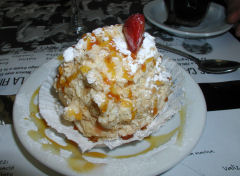 We finished off with the more interesting sounding of the two Uruguayan desserts – the Postre chajá de Paysandú. Now I’m not sure the Pierre would agree, actually being of British extraction and all, but to me it suggested an English trifle. Buried deep beneath this mound is a sponge cake, it’s topped with a peach flavored whipped cream, a thin layer of meringue, and then the whole thing drizzled over with caramel and a sifting of powdered sugar.
We finished off with the more interesting sounding of the two Uruguayan desserts – the Postre chajá de Paysandú. Now I’m not sure the Pierre would agree, actually being of British extraction and all, but to me it suggested an English trifle. Buried deep beneath this mound is a sponge cake, it’s topped with a peach flavored whipped cream, a thin layer of meringue, and then the whole thing drizzled over with caramel and a sifting of powdered sugar.
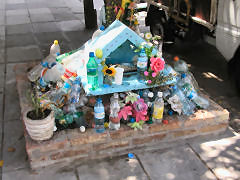 Out wandering around in the Palermo Viejo neighborhood I came across this sight at the corner of Thames and Santa Rosa. Whether it’s meant to be some sort of artistic statement or a shrine of sorts, I have no idea. There was no sign. It has a small shrine looking center to it – sort of an open dollhouse with a bed in it on which is a figure of a woman. It is surrounded by bottles of water and soda – each of them with a small amount of liquid remaining. They were carefully arranged, all sort of leaning in towards the house and the tree that backed it, but as to its purpose, I am at a loss.
Out wandering around in the Palermo Viejo neighborhood I came across this sight at the corner of Thames and Santa Rosa. Whether it’s meant to be some sort of artistic statement or a shrine of sorts, I have no idea. There was no sign. It has a small shrine looking center to it – sort of an open dollhouse with a bed in it on which is a figure of a woman. It is surrounded by bottles of water and soda – each of them with a small amount of liquid remaining. They were carefully arranged, all sort of leaning in towards the house and the tree that backed it, but as to its purpose, I am at a loss.
My friend Roberto sent this on in regard to what is, apparently a shrine:
By the way, I think the little doll you saw laying prostrate in a toy house surrounded by half filled bottles of beverages was a shrine to the Difunta Correa – a woman who supposedly was seeking her husband and went trekking out west to find him but died in route, when people found her body, her infant son was still allegedly alive and suckling from one of her breasts – so I think she is an impromptu quasi-catholic patron of travelers.
A little research…
[…] Of course, wandering builds up an appetite, and as long as I was there, it seemed worth trying another chivito. This time I grabbed a proper sandwich one from a little stand in the middle of the main street, Los Farolitos, at 270 Av. Gral. Flores, where two women were busily making a variety of grilled sandwiches on a countertop grill. This was the real deal – exactly what I was looking for, and even cheaper (48 uruguayos, or $2) than the sit-down restaurant (though they had a few patio type tables and chairs on the sidewalk out front), sandwich style, and an array of toppings to choose from. Same exact “layout” – steak, bacon, ham, cheese, fried egg – and then various sauces and relishes. While it may not be what the doctor ordered – in fact between chivitos and pamplonas, it’s hard to imagine that Uruguayans don’t have rocketing high cholesterol, it was delicious! […]
Dan,
There is a meaning of “La Celeste” you didn’t know at the time (I don’t know if someone told you after this entry).
It’s the color of the Uruguayan Soccer National Team shirt and just to say “Celeste” with the feminine determinate article in front, it means “La (camiseta) Celeste”, with the only meaning of the National shirt.
As Uruguay was twice soccer world champion and twice Olympic, it’s a matter of national pride.
Regards,
Gustavo
Nope, you’re the first to mention it – thanks! It’s why I like when people take the time to comment – I learn new things every day.
[…] they actually won a second time in 1950. And they’re winners at the dessert table too, with chajá, often referred to as “peaches in trees.” Peaches, whipped cream, sponge and meringue […]
[…] check out La Celeste, Bonpland 1944 in Palermo – I’ve been here before a few times, and reviewed it many, many moons ago, not long after I first moved here. I’d never tried the sandwich though […]